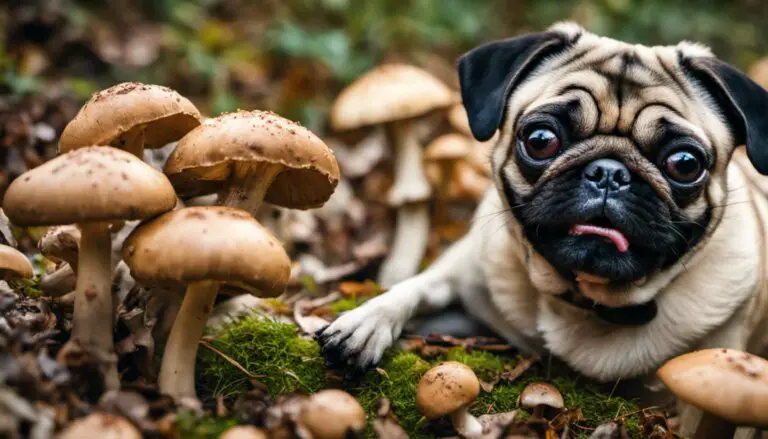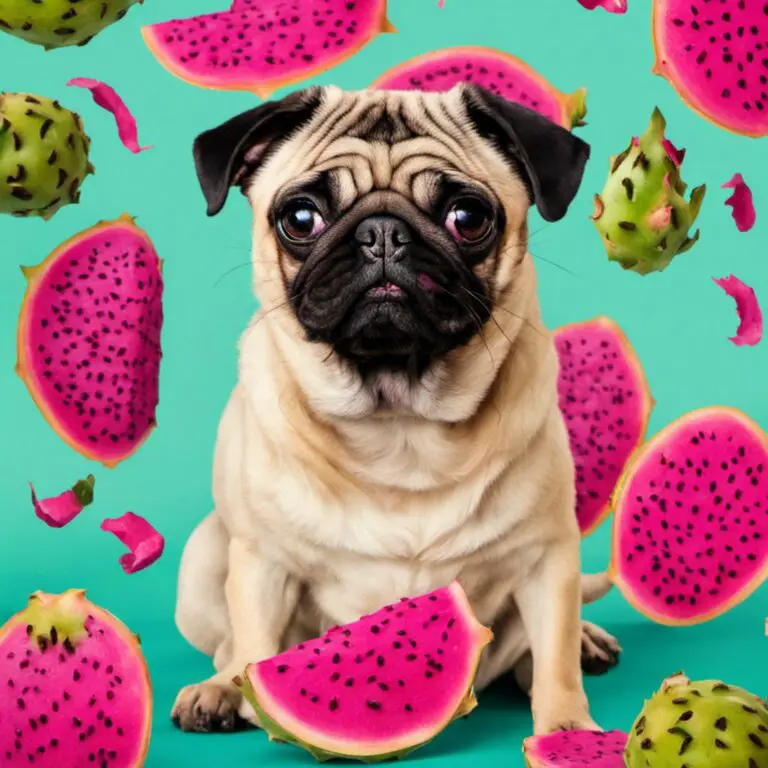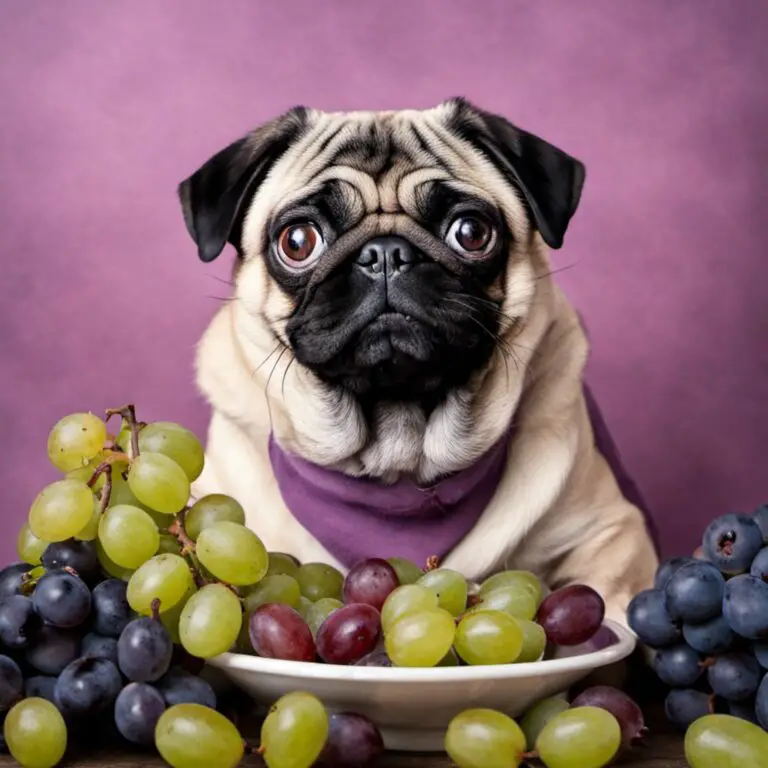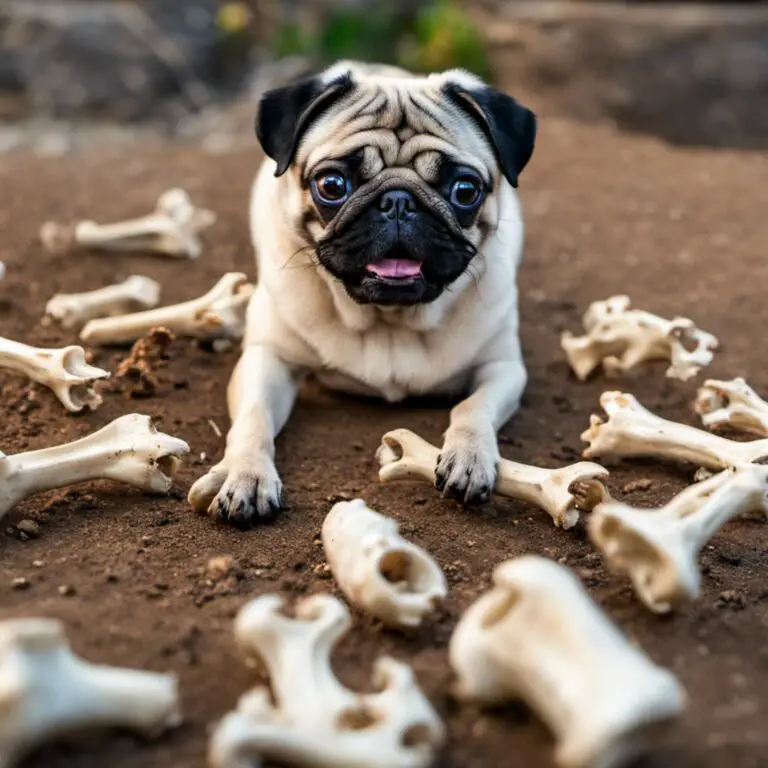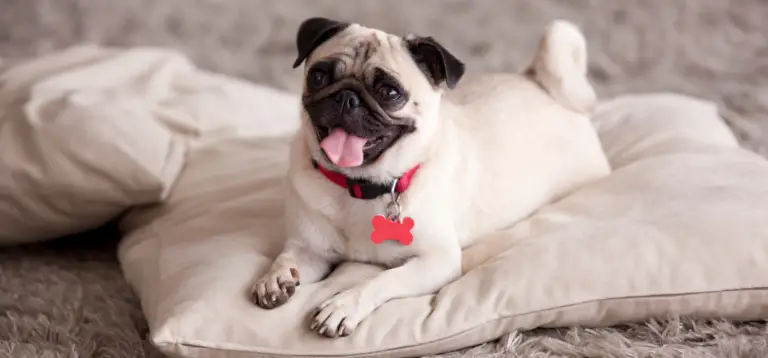Can Pugs Eat Pasta? A Clear Guide for Pet Owners

As a pug owner, you might wonder Can Pugs Eat Pasta as part of their diet. It’s not uncommon for pet owners to share their favorite foods with their pets. But knowing whether these foods are safe and healthy for your beloved pug is essential.

Pasta, in its plain form, is generally safe for dogs, including pugs, to consume source. Made from simple ingredients like eggs, flour, and water, these elements are not harmful to your dog. However, it is essential to serve pasta in moderation and avoid adding any sauces or toppings that may be toxic to your pug.
Remember that while small amounts of pasta can be an occasional treat, your pug’s primary diet should consist of foods specifically designed for their nutritional needs. Always consult with your veterinarian if you have concerns about introducing new foods into your pug’s diet.
Contents
Table of Contents
Understanding Pugs and Their Dietary Needs

As a pug owner, it’s crucial to understand the dietary needs of your furry friend to ensure they remain healthy and energetic. Pugs are small dogs with unique nutritional requirements that stem from their physical features and metabolism.
Get The Free Food Eating Guide That Keeps My Pug Happy and Playful Even at 13 Years Old
100% Beginner Friendly & Lists Real Foods Your Pug Can Actually Eat!
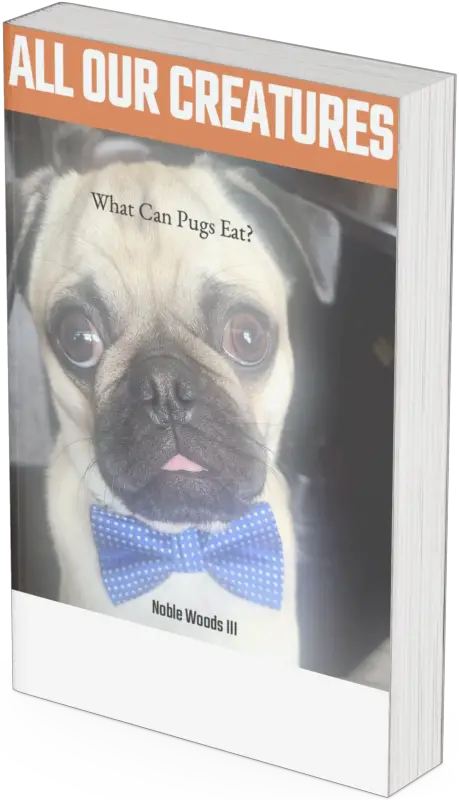
A balanced diet is essential for pugs to maintain a healthy weight, have a shiny coat, and stay energetic. The main components of a pug’s diet include high-quality meat or protein sources, healthy fats, and carbohydrates for energy. Additionally, providing your pug with essential vitamins and minerals found in fruits, veggies, and commercially available dog food is vital for well-rounded nutrition.
When it comes to protein sources, pugs thrive on meat-based proteins such as chicken or turkey. Avoid feeding them low-quality meats or heavily processed foods that can lead to gastrointestinal issues. To promote a healthy coat and support overall well-being, include omega-3 fatty acids, which can be found in fish oil or flaxseed oil.
Carbohydrates are another essential component of your pug’s diet, providing the energy they need for daily activities. However, choosing the right kind of carbohydrates is essential, as pugs can be prone to obesity. Stick to complex carbohydrates such as brown rice or sweet potatoes rather than simple carbohydrates, which can spike blood sugar levels.
It’s important to consider portion sizes and feeding frequency for pugs. Overfeeding can lead to obesity, which may exacerbate health issues such as respiratory problems and joint pain. To prevent this, use a measuring cup to portion out meals, and follow the guidelines on the dog food label.
In addition to the main components of their diet, you can provide your pug with fruits and vegetables as occasional treats. However, some foods are not safe for pugs or dogs in general, so be cautious about what you introduce into their diet. When considering pasta as a treat, remember that it should be plain and only given in moderation, as pugs don’t require a large amount of carbohydrates in their diet.
By understanding your pug’s dietary needs, you can ensure they enjoy a delicious and nourishing meal plan that supports their overall health and well-being.
Can Pugs Eat Pasta?
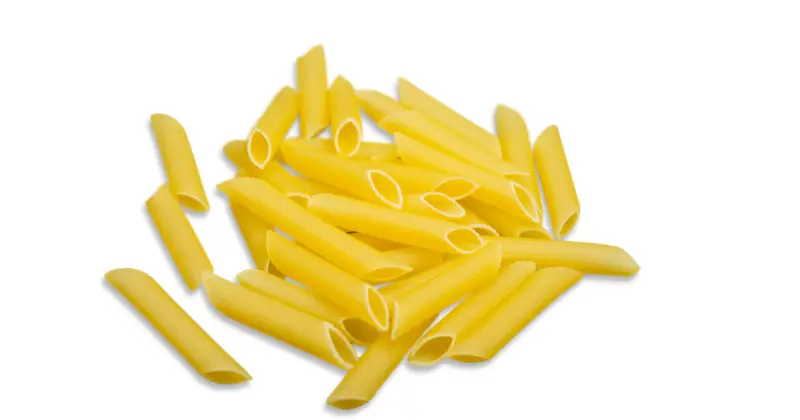
When it comes to feeding your pug, you might wonder if pasta is a safe option for them. Just like other dogs, pugs can indeed eat pasta. Plain pasta, cooked or uncooked, is typically okay for dogs, including pugs, as it is made from simple ingredients like eggs, flour, and water that are safe for them to consume.
However, it’s essential to remember that not all pasta dishes are suitable for pugs. You should avoid feeding your pug pasta that contains garlic, onions, or any other ingredient that might be harmful to them. To ensure their safety, serving them plain, unseasoned pasta is best.
Incorporating human food into your pug’s diet can be a fun way to provide them with a bit of variety. But, it’s essential to ensure that only healthy options like pasta are being offered. Certain human foods like chocolate, grapes, and raisins can be very toxic to pugs and should be avoided at all costs.
Knowing your pugs’ dietary needs and preferences is crucial when determining what kind of food they can eat is crucial. Pugs may have different dietary requirements than other dog breeds and might be more sensitive to certain ingredients. If you’re unsure about the best diet for your pug or whether a particular food item is safe, it’s always best to consult with your veterinarian for guidance.
In conclusion, pasta can be a safe and enjoyable treat for your pug when served plain and unseasoned. Remember to consider the ingredients in any pasta dish before feeding it to your pug, and always consult with a veterinarian if you’re unsure about a particular food item’s safety.
The Health Implications of Feeding Pasta to Pugs
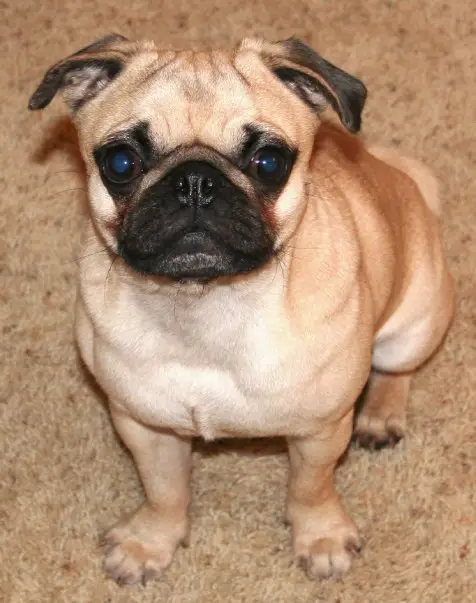
When feeding pasta to your pug, it is essential to understand the potential health implications. Plain or uncooked pasta is typically safe for dogs as it is generally made from simple ingredients like eggs, flour, and water 1. However, moderation is key, as excessive pasta consumption can lead to various health issues.
Overfeeding pasta to your pug can cause them to become overweight or even obese. Pasta is a carbohydrate, and consuming too many carbs can lead to weight gain in dogs, just as in humans. Although pasta can provide a source of energy for your pug, a healthy diet should contain a balanced blend of protein, fats, and carbohydrates 2.
Excessive pasta consumption may also cause adverse effects like vomiting and hives. While these symptoms are not common, they might occur if your pug has an underlying allergy or sensitivity to an ingredient in the pasta. Thus, it is essential to monitor your pet for any signs of distress and consult your veterinarian if you notice any changes in their health.
To reduce the risk of these health implications, consider incorporating different types of nutritionally dense food into your pug’s diet. For instance, focusing on getting enough protein (18% crude protein for adults and not exceeding 22% in dog food) and maintaining healthy levels of crude fatty acids (5% for adult pug’s food and 8% for a puppy’s food intake) can lead to a well-rounded and balanced diet 3.
In conclusion, if consumed in moderation, pasta can be a safe and enjoyable treat for your pug. Remember the importance of a balanced diet and monitor your pet for any signs of adverse effects to ensure their health and happiness.
Safe Human Foods for Pugs

As a pug owner, you may want to offer your furry friend some variety in their diet by introducing human foods. Thankfully, there are numerous safe options that can provide your pug with nutrients and enjoyment.
Among the various human foods, treats such as rice, chicken, and eggs can be given to your pug. These foods are rich in protein and provide essential nutrients which can promote your pet’s overall health. Likewise, fish like salmon is a great source of Omega-3 fatty acids that are beneficial for your pug’s skin and coat.
Vegetables and fruits contribute essential vitamins and fiber to your pug’s diet. Carrots and green beans are perfect options, as they’re low in calories while providing vitamins A and C. Similarly, apples are high in vitamins A and C but remember to remove seeds when serving them to your pug. Sweet potatoes and blueberries also contain antioxidants that can enhance your pet’s immune system.
Bananas, oranges, and watermelon can be given to your pug in moderation. These fruits provide vitamins and natural sugars, which can be refreshing. However, ensure to remove seeds or rind to prevent choking. Meanwhile, raspberries and cherries are rich antioxidants, but cherries need to be pitted before sharing with your pug. It’s essential to avoid green tomatoes since they contain toxins that can be harmful to dogs.
Barley can be added to your pug’s diet, as it provides fiber, vitamins, and minerals. Additionally, cheese can be an occasional treat, considering your pug is not lactose intolerant. Opt for low-fat options like cottage cheese or mozzarella.
In summary, a variety of human foods can be safely included in your pug’s diet. Ensure to introduce these foods gradually and monitor any adverse reactions. Keep portions small to prevent excessive calorie intake and maintain optimal health for your beloved pug.
Can Pugs Eat Pasta? Watch this
Dangerous Human Foods for Pugs
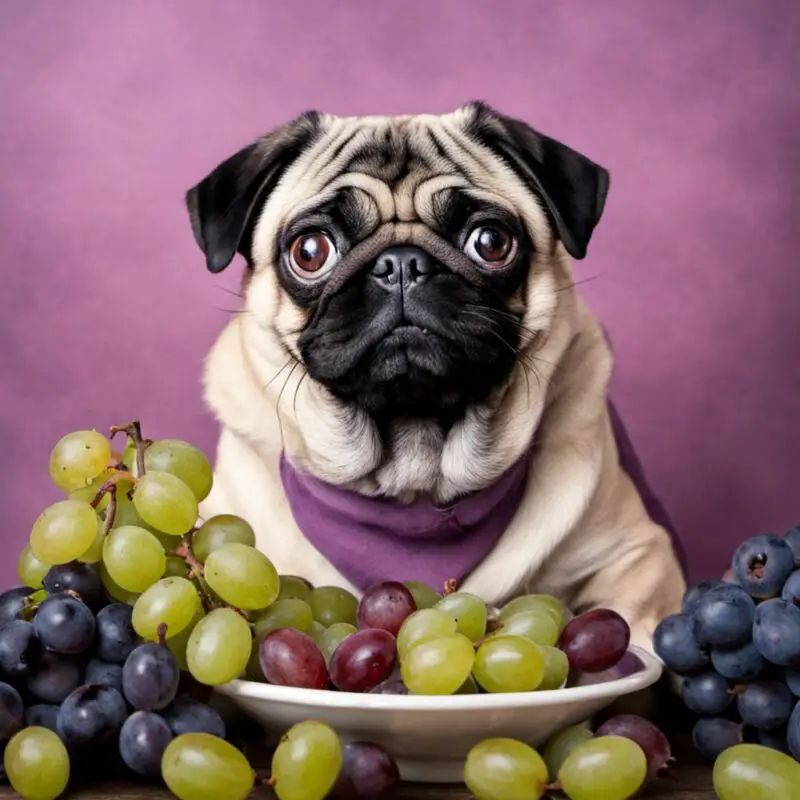
As a pug owner, knowing which human foods are harmful to your furry friend is essential. Feeding your pug the wrong food can lead to severe health problems or even be fatal. This section will discuss some of the most dangerous human foods for pugs.
Garlic and onions contain compounds that can cause anemia in dogs. Anemia leads to a reduced number of red blood cells, impairing their ability to carry oxygen. Symptoms of anemia in pugs may include lethargy, shortness of breath, and pale gums. It’s best to avoid feeding your pug these vegetables.
Chocolate is highly toxic to dogs due to the presence of theobromine. Theobromine affects the central nervous system and can cause vomiting, diarrhea, rapid breathing, increased heart rate, and even seizures. Ensure that chocolate is always kept out of your pug’s reach.
Xylitol, a sugar substitute commonly found in sugar-free products, can cause a rapid release of insulin in dogs, leading to hypoglycemia (low blood sugar). This can result in vomiting, loss of coordination, and seizures. Always check the labels of sugar-free foods and avoid feeding them to your pug.
Grapes and raisins are toxic to dogs and can cause kidney failure. It is not entirely clear what substance in grapes and raisins causes this toxicity. Still, even small amounts can be harmful to your pug. Keep these fruits away from your pet.
Avocados contain a substance called persin, which can cause vomiting and diarrhea in dogs. While not typically lethal, keeping avocados out of your pug’s diet is best.
Some mushrooms can be toxic to dogs. Ingesting toxic mushrooms can cause vomiting, diarrhea, tremors, seizures, and even death. To be safe, avoid feeding your pug any type of mushroom.
Caffeine is harmful to dogs, as it can cause elevated heart rate, tremors, and seizures. Be cautious when leaving coffee or caffeinated drinks within your pug’s reach.
Macadamia nuts can cause weakness, vomiting, fever, and muscle tremors in dogs. They should not be offered to your pug as a treat or be present in their food.
Fat trimmings from meat can lead to pancreatitis in dogs, a painful and potentially life-threatening condition. Avoid feeding your pug any fatty leftovers.
Finally, avoid giving your pug any moldy or stale food. Mold can produce harmful toxins, leading to vomiting, diarrhea, and even rashes. Always ensure the food you offer your pug is fresh and safe for consumption.
By being aware of these dangerous human foods, you can protect your pug’s health and ensure they live a happy and safe life.
Understanding Wet and Dry Dog Food for Pugs
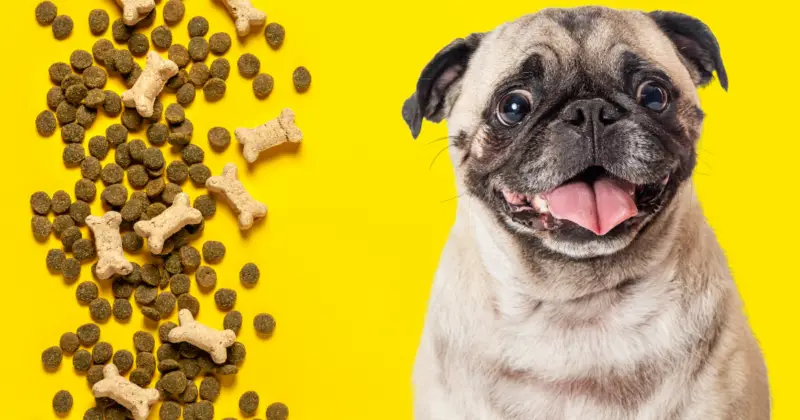
When choosing the right food for your Pug, it’s essential to understand the differences between wet and dry dog food. Both types of food offer advantages and drawbacks, but by considering the specific needs of your Pug, you can make an informed decision.
Wet dog food can be more palatable and appealing to some dogs due to its moisture content and aroma. The hydration provided by wet food can be beneficial for Pugs that don’t drink enough water or have urinary tract health issues. However, wet food may contain higher fat content and lower nutrient density than dry dog food. Be sure to check the nutritional label to ensure that the wet food chosen for your Pug is balanced and meets their dietary requirements.
On the other hand, dry dog food has advantages like convenience, cost-effectiveness, and dental health benefits. The kibble shape and texture can help clean your Pug’s teeth as they chew. Dry dog food, particularly formulas designed for smaller breeds like Pugs, generally contains the necessary calories, fat, and nutrients.
Whether you choose wet or dry dog food, looking for formulas with high fiber content is crucial. Fiber aids in digestion and can help prevent your Pug from overeating. As Pugs are prone to obesity, monitoring their food intake and adjusting accordingly is essential. Make sure to consult your veterinarian if you have concerns about your Pug’s nutrition or weight.
Lastly, remember that treats and snacks should be given in moderation and shouldn’t make up more than 10% of your Pug’s daily caloric intake. When giving treats, opt for ones with minimal additives and wholesome ingredients. Some Pug-friendly fruits and vegetables, like ripe tomatoes or cooked plain pasta, can be given as occasional snacks. However, always introduce new foods gradually and watch for adverse reactions.
Is Raw Diet a Good Option for Pugs?
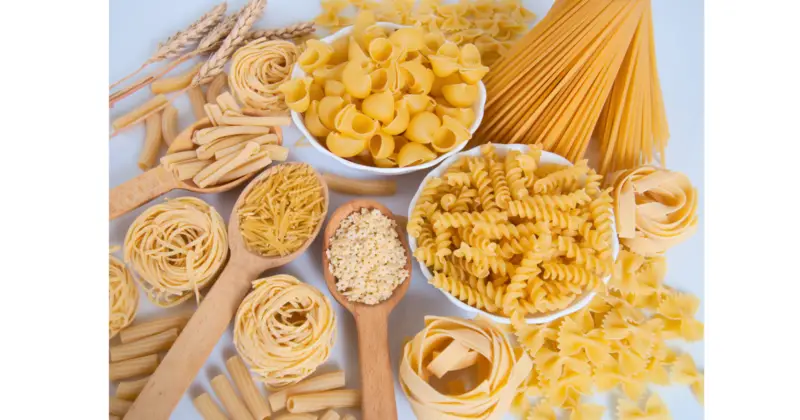
If you’re considering a raw diet for your pug, it’s essential to understand the potential benefits and risks associated with this feeding approach. The main idea behind a raw diet is to provide your pug with a more natural, unprocessed food source that mimics the diet of their wild ancestors and includes meat, bones, and organs.
A raw diet can be achieved through two primary methods: the Prey Model Raw (PMR) and the Biologically Appropriate Raw Food (BARF) diet source. Both options aim to deliver a balanced and varied diet, ensuring your pug receives essential nutrients.
One significant benefit of a raw diet is a strengthened immune system for your pug. Avoiding chemically processed foods and inflammation-causing ingredients makes your pug less likely to experience illnesses and require fewer medications.
Protein plays a crucial role in maintaining your pug’s overall health, especially as part of a raw diet. Providing your pug with high-quality protein sources such as lean meats and fish helps support their muscle development and boosts energy levels.
Despite its benefits, a raw diet may not suit every pug. It’s important to be aware of potential risks, such as bacterial contamination or an unbalanced diet. Careful planning and knowledge of your pug’s specific nutritional needs are vital to achieving a balanced, healthy diet source.
In conclusion, a raw diet can potentially benefit your pug, but careful planning and execution are required. As always, consult with your veterinarian before making any substantial dietary changes to ensure it’s the best approach for your pug’s unique circumstances.
Feeding Puppies: Can Pugs Eat Pasta?

As a puppy owner, you might wonder if offering pasta to your little canine companion is safe. In general, plain pasta is safe for dogs and puppies and can be given in moderation as it is made from simple ingredients like eggs, flour, and water, which are not harmful to their source. However, there are a few things to consider while feeding pasta to puppies.
Firstly, although plain pasta won’t harm your puppy, it lacks nutritional value and won’t contribute significantly to their overall health. Remember that pasta should not replace their regular, balanced diet but rather serve as an occasional treat source.
Secondly, portion control is crucial when feeding pasta to your puppy. Puppies have smaller stomachs and might experience digestive issues if fed large quantities of pasta. Plus, pasta is a starch-based food, and consuming too much of it can lead to weight gain source.
To serve pasta to your puppy, simply cook it without any added salt, sauce, or seasoning, as some ingredients used in pasta dishes, such as garlic and onions, can be toxic to dogs. It’s best to avoid adding butter, oil, or cheese, as these can be high in fat, leading to possible weight gain and digestive issues.
In conclusion, while pasta doesn’t provide significant nutritional benefits to puppies, it is safe to feed them plain and properly prepared pasta in moderate amounts. Remember that pasta should never become a staple in a puppy’s diet and that their primary source of nutrients should always be a balanced, age-appropriate dog food.
Frequently Asked Questions: Can Pugs Eat Pasta

Can pug dogs consume spaghetti?
Yes, pug dogs can consume spaghetti in small quantities as an occasional treat. However, it is important to feed them plain, cooked spaghetti without any sauce. Many sauces, such as marinara, contain garlic and onions, which are harmful to dogs as mentioned by The Spruce Pets.
Is it safe for pugs to eat lasagna?
No, it is not safe for pugs to eat lasagna. Lasagna contains multiple ingredients that could be harmful to your pug, such as garlic, onions, and certain herbs and spices. These ingredients may cause digestive issues or even toxic reactions in your pug.
What kind of pasta is suitable for pugs?
Plain, cooked pasta without any sauce or added ingredients is generally safe for pugs to consume in moderation. Ideally, choose a simple pasta like boiled macaroni or spaghetti, as these are less likely to cause digestive issues. Avoid feeding pasta with rich sauces or spices, as these can be harmful to your pug.
Are noodles harmful to pugs?
Plain, cooked noodles without any sauce or added ingredients are not harmful to pugs when consumed in moderation. Similar to pasta, it is essential to avoid feeding them noodles with sauces or spices that could be toxic. Always monitor your pug’s response to new foods and consult your veterinarian for advice on their specific dietary needs.
Can pugs have macaroni?
Yes, pugs can have cooked macaroni without any added ingredients as an occasional treat. Remember to keep portions small and serve the macaroni plain to avoid any potential harm from sauces or spices. The key is moderation, as overfeeding pasta in general can lead to weight gain and unhealthy dietary habits.
Is it alright for pugs to eat cheese with pasta?
Cheese can be fed in moderate amounts to pugs as it is a good source of protein and calcium. However, not all cheeses are suitable for pugs, and some can contribute to weight gain or other health issues. It is advised to use low-fat cheese options, such as mozzarella or cottage cheese, in small quantities while avoiding feeding pugs cheese with pasta to prevent excessive calorie intake. Always monitor your pug’s reaction to new foods and consult your veterinarian for dietary guidance.

